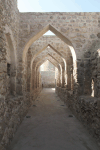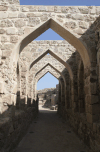
View of Qal'at al-Bahrain (Bahrain Fort). (616k)
Bahrain holds the remnants of Dilmun, one of the many Ancient Civilizations that I saw during my travels.
From the Dilmun entry in Wikipedia:
Dilmun was an ancient Semitic-speaking polity in Arabia mentioned from the 3rd millennium BCE onwards. Based on textual evidence, it was located in the Persian Gulf, on a trade route between Mesopotamia and the Indus Valley Civilisation, close to the sea and to artesian springs. A number of scholars have suggested that Dilmun originally designated the eastern province of Saudi Arabia, notably linked with the major Dilmunite settlements of Umm an-Nussi and Umm ar-Ramadh in the interior and Tarout on the coast. Dilmun encompassed Bahrain, Kuwait, Qatar and the eastern portion regions of Saudi Arabia. This area is certainly what is meant by references to "Dilmun" among the lands conquered by King Sargon of Akkad and his descendants.
The great commercial and trading connections between Mesopotamia and Dilmun were strong and profound to the point where Dilmun was a central figure to the Sumerian creation myth. Dilmun was described in the saga of Enki and Ninhursag as pre-existing in paradisiacal state, where predators don't kill, pain and diseases are absent, and people don't get old.
Dilmun was an important trading center. At the height of its power, it controlled the Persian Gulf trading routes. According to some modern theories, the Sumerians regarded Dilmun as a sacred place, but that is never stated in any known ancient text. Dilmun was mentioned by the Mesopotamians as a trade partner, a source of copper, and a trade entrepôt.
The Sumerian tale of the garden paradise of Dilmun may have been an inspiration for the Garden of Eden story.
All pictures are © Dr. Günther Eichhorn, unless otherwise noted.
From the Qal'at al-Bahrain entry in Wikipedia:
The Qal'at al-Bahrain, also known as the Bahrain Fort or Portuguese Fort, is an archaeological site located in Bahrain, on the Arabian Peninsula. Archaeological excavations carried out since 1954 have unearthed antiquities from an artificial mound of 12 m (39 ft) height containing seven stratified layers, created by various occupants from 2300 BCE up to the 18th century, including Kassites, Greeks, Portuguese and Persians. It was once the capital of the Dilmun civilization.
Qal'at al-Bahrain – Ancient Harbour and Capital of Dilmun is a UNESCO World Heritage Site.












From the Dilmun Burial Mounds entry in Wikipedia:
The Dilmun Burial Mounds are a number of necropolis areas on the main island of Bahrain dating back to the Dilmun, the Umm al-Nar culture, and later eras. Known since ancient times as an island with a very large number of burials, the (originally) quite a number of square kilometers of mounds were said to be one of the largest cemeteries in the ancient world. The cemeteries are concentrated in the north of the island, on the hard stony areas slightly above the arable farming soils – the south of the island is mainly sandy and desert-like. Recent studies have shown that the estimated/approximately 350,000 ancient grave mounds could have been solely produced by the local population over a number of thousands of years. The graves are not all of the same era, or of exactly the same styles, and can vary considerably in size in different areas of the moundfield. Research, under the auspices of the Bahrain National Museum (with the Bahrain Historical and Archaeological Society taking a keen interest), is still continuing, to establish a firm timeline for all these variations and continuations, as well as considering the implications for the society or societies that produced them.
The Dilmun Burial Mounds are a UNESCO World Heritage Site since 2019.







This page contains 19 pictures

Main page for البحرين (Bahrain)
Page last updated on Fri Dec 2 12:44:23 2022 (Mountain Standard Time)
Page last updated on Thu Apr 25 17:07:14 2024 (Mountain Standard Time)
Dilmun Civilization on aerobaticsweb.org